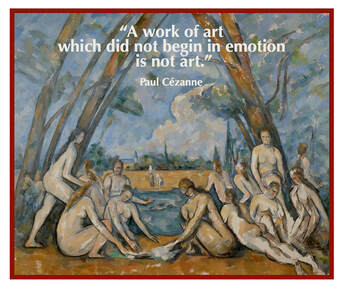|
Joan M. Rehlin
This mini art history post highlights French artist Paul Cézanne (1/19/1839–10/22/1906). Identified with Post-Impressionism, his work influenced the transition from late 19th century artwork to a fundamentally different type of art in the 20th century, including Cubism. Cézanne treated nature by the cylinder, the sphere, the cone, and his paintings represent an architectural style with simple forms and planes of color to depict the world as he saw it. Born in Aix-en-Provence, Cézanne was a beneficiary of his father’s financial success, resulting in a comfortable lifestyle that was unavailable to most of Cézanne’s contemporaries. At 18 he attended the School of Drawing in Aix and then, at his father’s request, the University of Aix Law School. He studied drawing in both schools and, at 22, was encouraged by his friend Émile Zola to move to Paris to pursue his artistic development. In the 1880s, Cézanne returned to his beloved Provence in the south of France. He painted landscapes, portraits, still lifes, and various studies of bathers which are notable due to the lack of nude models. Beginning in 1863, Cézanne’s art submissions were rejected over and over by the jury of the Salon, which was the official exhibition of the Académie des Beaux-Arts in Paris. Cézanne’s rejected paintings were instead accepted by the Salon des Refusés, which displayed art unaccepted by the Salon. Finally, due to fellow artist Antoine Guillemet’s intervention, Cézanne had three paintings accepted for exhibition in the Salon in 1882. He also exhibited at the first and third Impressionists exhibitions, 1874 and 1877, and in several other venues. In 1895 he had his first solo exhibition, presented by Ambroise Vollard, an important Parisian dealer. Although he attracted the attention of dealers and art collectors whose commissions provided additional financial support, Cézanne’s work was often ridiculed, not understood, and not well-received by established galleries and the general public. Despite those early rejections, in his later years Cézanne’s paintings became sought after, and his work earned respect from the younger generation of painters, including Picasso. Cézanne’s artwork with geometric and optical artistic exploration influenced those artists to experiment with the fractured form, which became known as Cubism. Although afflicted by health problems, Cézanne continued to paint the last few years of his life. In the fall of the year following his death, Cézanne’s paintings were exhibited in a large retrospective at the renowned Salon in Paris, which confirmed his standing as one of the most influential artists of the 19th century. Among Cézanne’s series of Bathers paintings is Les Grandes Baigneuses (The Large Bathers 82.8" x 98.7"), shown here, which is hanging in the Philadelphia Museum of Art. Les Grandes Baigneuses, 1905, oil on canvas, Paul Cézanne
0 Comments
Leave a Reply. |
ART BLOGWelcome to our Art Blog where we occasionally present topics of interest in the fine art world, including featuring artists other than Jim Rehlin. Some of the artwork has been created by long-departed but well-known greats; some, by compelling contemporary artists. All will be pieces we find worthwhile to share with you. If you like any of these, consider sharing the posts forward to your own blogs and other social media. |
|
Artwork by Jim Rehlin.
Website content and modifications ©2024 Rehlin Graphics / Fine Art. All rights reserved. Click HERE to Visit and Like Rehlin Graphics / Fine Art on Facebook. THANKS! |

 RSS Feed
RSS Feed
